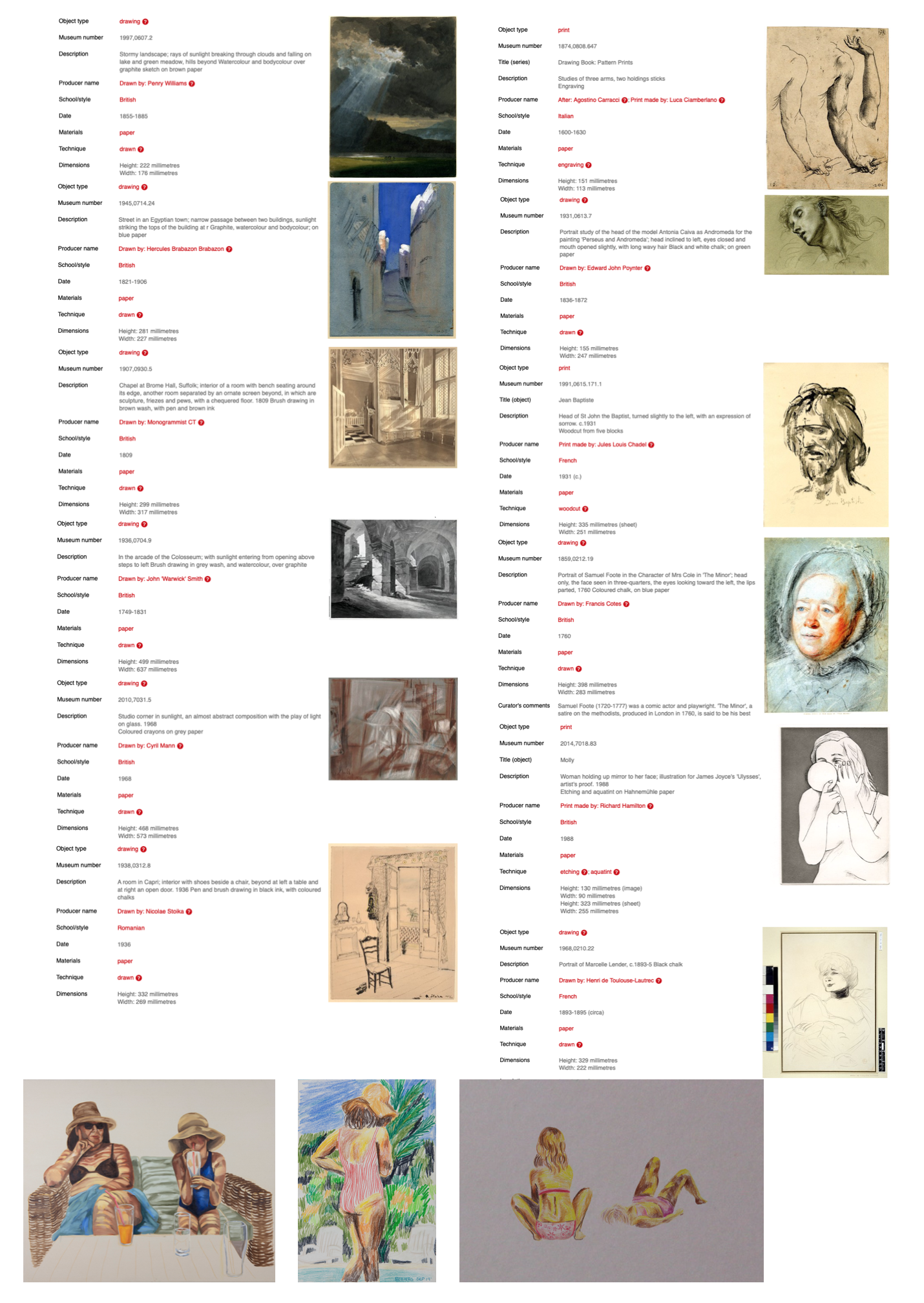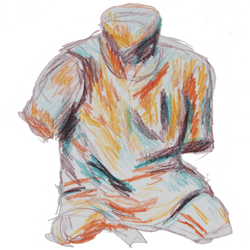British Museum - Prints and Drawings Workshop Proposal with Sarah Jaffrey.
Attending Workshops by Sarah Jaffrey at The British Museum Prints and Drawings Room, we were given the opportunity to build our own workshop proposal given to the public in the museum which would be funded by the Bridget Riley Foundation. Writing up my own workshop proposal was highly reflective and I ended up making some discoveries that had not been realised about my own work, some of which are now in my artist statement.
Full Report - Download (Google Drive).
Language of Light: Sunlight as an entry-point into Drawing
Bridget Riley Art Foundation at the British Museum Workshop Proposal 2020.
100 Word Summary:
This workshop explores patterns of sunlight as an entry point to experience an image differently and manipulating it to your advantage by using contrast as a path for quicker, more intuitive drawing and analysis. Exploring how the description of an image can become simplified by looking at the rays of light to realise a shape or form within a 2D piece of work. Through this process the pace increases, reducing fragility and creating bold, purposeful marks. Using sunlight to immediately transform the feeling and emotion in an image, situating itself in a moment by giving it a clear time as it moves and shifts, intangible to words.
Materials:
White, Grey/Tonal, Black Paper.
Tracing Paper.
White and Black Pencils and Charcoal.
Rubber.
Lesson Plan with Timings:
10-12pm (2 Hours)
***Note: all drawn activities from the works, public are invited to change works or focus on the same work throughout all exercises.
10:00-10:05 OVERALL INTRODUCTION
To me, my practice and the theme of todays session (and why I chose it)
About me: I come from a painting background. Studied painting BA at Wimbledon UAL. My own drawings rely on patterns or beams of light to become realised. Looking at the language of light using colour and studying the contrast in tone and its value to boost the formulation of an image. As my work developed I realised the importance of drawing to my thought process. I stopped using sketchbooks by accident, it was really just because I was trying to stop size constraints and to be less formal, almost like doodles and it somehow gave the importance to the drawing that had never had time to stand in its own right before. By doing this I allowed my thinking behind an image to shift and grow into something that didn’t feel tangible with words, but did with light. More and more I have found that all the images I liked, either had stripes or some other pattern, or if it didn’t, it had direct sunlight which created its own pattern with the beams.
With this realisation I wasn’t sure why I absolutely hated something that didn’t have a contrast, for no apparent reason, otherwise it just wasn’t fun, quite frankly, I felt it was boring. I also didn’t know why if I felt I had to draw, it could only be an isolated object, single-ing out an object in a still life, no longer a scene or a narrative. But light allows for there to be a story, as it sets a time of day, and weather, so probably an emotion. If anything, it gives it life.
Looking at artists that also rely heavily on this, such as Eric Fischl and Walter Sickert in my own practice. My own work relies on the archival process of revisiting drawings or photographs, so this is just as much for me - I want to study the pieces and sit and draw from them, so I will also be drawing when you all do, but that’s not to say I’m not here to chat or ask questions to.
Ask if there is anything that strikes them about the selection.
10:05-10-:20 INTRODUCTION TO WORK
Roughly one min each. Ensuring to highlight why each one was chosen and how it proves, or disproves a way of thought through drawing. As well as a date, slight history of artist if interesting or relevant and anything noteworthy about the artwork. Notice small nuances between them, allowing for questions as and when they come. EG. What can you infer from these images? Do they all have the same tone or does the light reflect different stories? Difference when using monotone or colour, is one more successful than the other, how much does the colour really matter? Does the purpose come through anyway? How does the light change how you see the work? Is it necessary? etc.
This invitation to look, and to have a slight background of each work will familiarise the viewer when it comes to the exercises.
10:20-10:25 BRIEF ACTIVITY (5 Mins)*
Materials: Own Choice. Recommend Pencil on White paper.
Prompt: Mapping out and drawing an image how you normally would, just being conscious of light and dark. Light sketches to loosen up the hand.
Developing a sensitivity to the changes made in drawing when focusing on tonal contrasts, including what the public feel comfortable with and also getting to know the images a little more.
10:25-10:30 Reflect,
Questions, Did it change how you looked? Would you have chosen to draw that image like this or differently? Did you like the drawing you chose? Is it different to how you would normally approach this artwork?
10:30-10:37 BRIEF ACTIVITY (7 Mins)
Materials: On Black Paper with White Pencil.
Prompt: Using the idea of the “negative” black page for the dark. Does inverting the standard process of light to dark help you see in a different way? So instead of filling in dark, beginning with the highest value of light and not thinking about the subject. Does this alter how you think about it? Is it easier or harder to approach this way? Did it change how you felt about the image when trying this way of developing a thought process?
10:37-10:40 Reflect,
Questions How do you think these artists have used light and dark to their advantage? Do you think they were successful in their approach? Do they feel more or less resolved with or without them? Does it work as a structure?
10:40-10:50 BRIEF ACTIVITY (10 Mins)
Materials: On Grey/Tonal Paper, Using Black and White Pencil or Looser, Charcoal and White Chalk.
Prompt: Look at drawing, the light beams coming in, then working outwards from there on the rest of the room or curving around the figure. Try and not draw the subject, but the light and dark/positive and negative areas. Think of the light as the shapes, disassociate from what you know them to be. Tonal Values as key to placement.
10:50-10:55 Reflect
Questions, Did having a tonal background make it easier or harder? Did only having light and dark to add make it easier?
10:55-11:10 —BREAK— (15 MINS)
11:10-11:15 RECAP
Looking at the works, have your ideas changed at all? Maybe highlight some aims, light/dark, Questions. Does sunlight as a specific source change the mood at all? Does the brightness of that vs. A small lamp create gravitas?
11:15-11:30 IN DEPTH ACTIVITY (15 Mins)
Using charcoal to cover the page, and a rubber to remove the charcoal. This way you can remove the dark, rather than introducing light.
11:30-11:35 Reflect
Questions.
11:35-11:50 IN DEPTH ACTIVITY (15 Mins)
Using a technique of your own choice, In depth long study using the techniques of looking we have covered today. Transfer light from one image to another. Imagine one light source or use a light source from another work, into one of your choice. Feel free to use tracing paper as a reference guide-by giving it stripes etc. Using whichever materials and technique. Thinking about light and the things we have learnt. These 15 mins work as a springboard into your own practice.
11:50-12:00 SUMMARY AND QUESTIONS (10 Mins)
Was one technique easier than another? What have you learnt? Has it changed the way you would approach drawing in the future?
Reflect back and draw in with the works from the collection.
Basic Background Information for Introduction:
https://research.britishmuseum.org/research/collection_online/collection_object_details.aspx?objectId=726545&partId=1&searchText=sunlight+drawing&images=true&view=list&page=1
Drawn By Penry Williams, Welsh but lived in Rome, 1855-85, Watercolour and body colour over graphite sketch on brown paper. Think about the beginning, using brown paper, and sketching into it.
Also studied in Rome, the death of his brother meant his inheritance allowed him to travel and continue painting. He was: “Living for Art, and Sunshine”. Which is why this is from Egypt. He was inspired by Velázquez and Turner. Did not need to and therefor didn’t sell his work until he was elderly, encouraged by John Singer Sargent, his friend, who also urged him to hold his first exhibition.
British working in Brome from 1809.. Don’t know much more about him.
John Warrik Smith, Lots of architectural and landscape with weather clouds mountains etc.
One of the few black and white pieces in the collection, surprisingly.
1968, Very specifically explored the dimensions added to figurative art through sunlight.
https://research.britishmuseum.org/research/collection_online/collection_object_details.aspx?objectId=722959&partId=1&searchText=interior+drawing&page=1
https://research.britishmuseum.org/research/collection_online/collection_object_details.aspx?objectId=1563052&partId=1&searchText=pattern+drawing&images=true&view=list&page=1
https://research.britishmuseum.org/research/collection_online/collection_object_details.aspx?objectId=739173&partId=1&searchText=expression&images=true&page=7
https://research.britishmuseum.org/research/collection_online/collection_object_details.aspx?objectId=3349768&partId=1&searchText=expression&images=true&page=2
https://research.britishmuseum.org/research/collection_online/collection_object_details.aspx?objectId=750408&partId=1&searchText=sunlight+drawing&images=true&view=list&page=1
https://research.britishmuseum.org/research/collection_online/collection_object_details.aspx?objectId=3590209&partId=1&searchText=expression&images=true&page=16
https://research.britishmuseum.org/research/collection_online/collection_object_details.aspx?objectId=719616&partId=1&searchText=pattern+drawing&images=true&view=list&page=7


